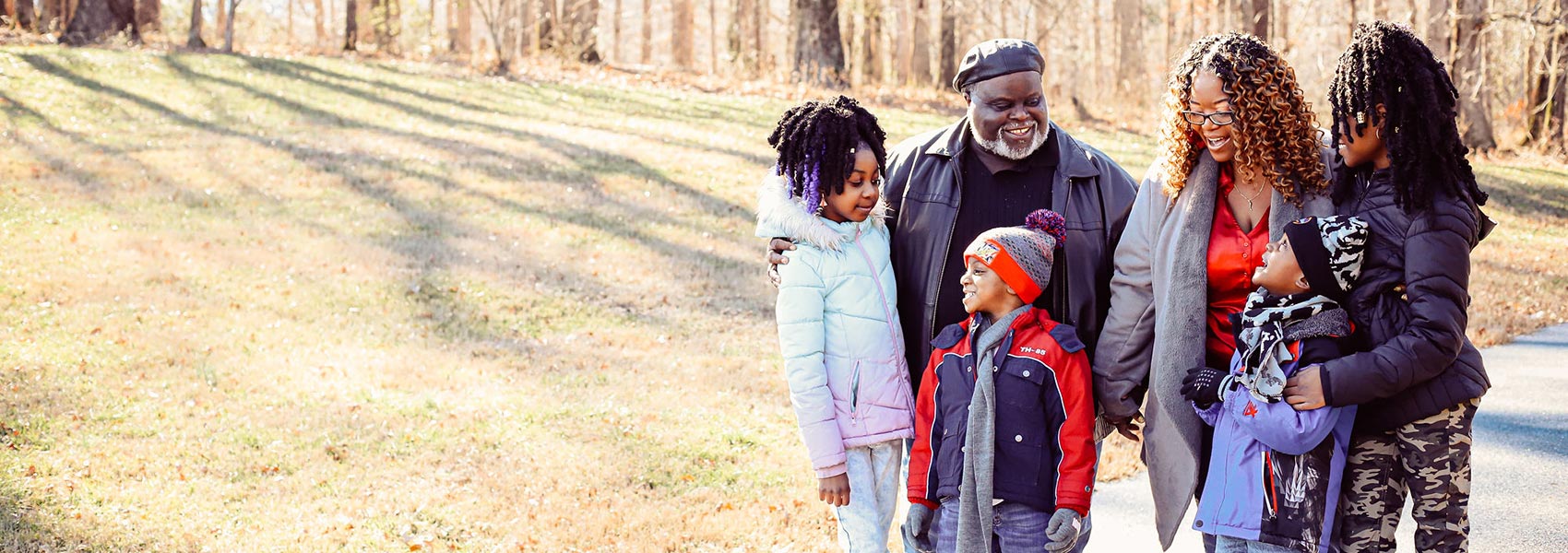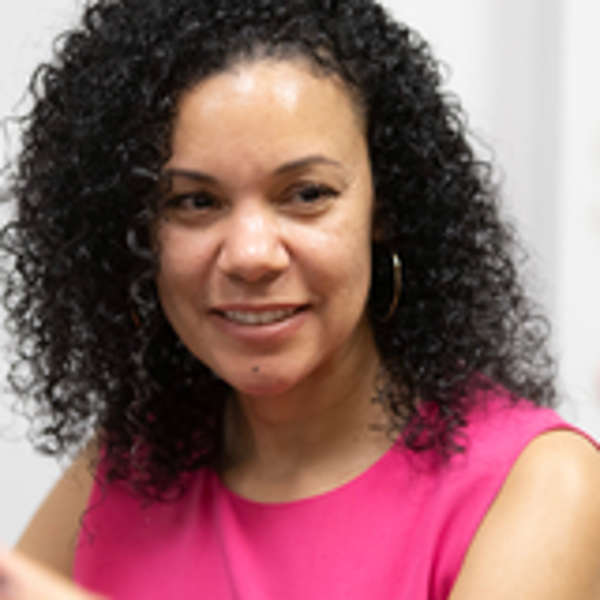4 things to know about adopting sibling groups
Learn why there's no such thing as "instant family" and other common misconceptions.
Brad Kramer

Byine and Johnny distinctly remember the first time they saw the faces of the four children who would soon become part of their family. They were scrolling through a Georgia website that lists children waiting to be adopted, and the connection felt instant. Byine remembers praying, “God, if we are the right family for these children, make it happen.”
When Byine and Johnny married later in life, they decided to pursue adoption and felt called to adopt a group of siblings. They knew that sibling groups are harder to place together in a single adoptive home, and they often wait years to be adopted. Yet adopting four children at once felt overwhelming at first. Guided by their faith, they pushed past their fears and offered their home to these children. In mid-2020, Byine and Johnny finalized the adoption with a judge over Zoom (due to COVID-19 restrictions), and the four children—ages 4, 6, 8, and 11—were officially joined together into an adoptive family.
There’s a desperate need for more adoptive families to say “yes” to sibling groups. By adopting siblings, you’re helping children who have already been through unimaginable loss be together with their brothers and sisters in the same home—rather than being separated into multiple families.
Here are four things you should know about adopting a sibling group:
1. You could be reconstructing and constructing family at the same time
It’s hard to find a single foster home for larger groups of siblings, according to Maggy Simpson, a Bethany adoption specialist who worked with Byine and Johnny. Groups of siblings are often placed into multiple foster homes, compounding the trauma of being separated from their biological parents. And if they leave a foster family to come into their new adoptive home, they may be mourning that loss as well.
Before being adopted, Byine and Johnny’s four children had lived in three different foster homes. Thomas* and Jayden, the youngest children, had never even met their older sisters. When they came into the home, they had to learn how to be siblings at the same time they were adjusting to new parents in a new home. They had to learn how to share, how to resolve conflicts with each other, and how to ask each other for help.
Byine and Johnny have been amazed at how the children are learning to care for each other—they call it “sibling therapy.” Thomas, the youngest child, came into the home with a significant speech delay. His older siblings have encouraged him to use words rather than just sounds, and together with professional speech therapy, he has made remarkable progress in just a few months.
2. Each child will have unique personalities, needs, and journeys
It’s worth repeating and underlining: When adopting siblings, each child will have different needs and bring their own complex emotions into the new home. This is the most important thing to understand about adopting siblings, according to Simpson.
Each child will experience the joy and grief of adoption differently. Families must make space for each child to express their grief in their own way and in their own time.
Byine and Johnny have been living this reality. Thomas and Jayden, who entered foster care as young children, are slowly beginning to understand that their previous foster parents were not actually their biological parents. Laila and Jasmine, the two older girls, have been helping the boys make sense of their life experiences.
The girls have unique challenges of their own. Laila had a strong attachment to her previous foster parents and has struggled to understand why she can’t live with them anymore. “We’ve had to have some very grown-up conversations with all the children,” says Byine. “We try to answer their questions as best as we can.”
These experiences are very common in sibling adoption, says Simpson. Her advice for parents like Byine and Johnny is to stay focused on what is best for the kids. The reason siblings are adopted together is because sibling separation is harmful for children (in most cases—there are exceptions). Sibling adoption is complex and messy and sometimes frustrating, but it’s usually the healthiest and best option for the children involved. Simpson urges adoptive parents to celebrate the good relationships the kids did have with previous foster families, and always show empathy for the grief the kids are experiencing.
Each of Byine and Johnny’s children has a different personality and needs their own type of care. One of the siblings has a developmental disorder that sometimes makes it difficult for her to express her feelings or opinions. Another sibling is more easygoing and has adjusted more quickly, up to this point. Byine and Johnny are committed to helping each of their children grow and heal on their own schedule.
3. There’s no such thing as “instant family”
The legal process of adoption can happen quickly, but the process of building and bonding a family is a slow and unpredictable journey. This is true of all adoptions, but even more so when adopting a sibling group.
To be successful when adopting sibling groups, families need to find an effective balance between structure and flexibility, advises Simpson. All children—and especially those who have been through chaotic and traumatic journeys—benefit from clear expectations and predictable routines. However, adoptive parents need to be prepared for the reality that “very little will go according to plan for a very long time,” she says. The key is to be patient and always stay committed to each child’s best interests.
Adoption is a lifelong journey for both adoptive parents and the adopted child. “Adoption is grief and joy together,” Simpson says. “In some moments, the grief is greater than the joy. Sometimes it’s the opposite. That’s an adoptee’s entire life.”
4. You can do it, but you can’t do it alone
For many people, the thought of adopting multiple children—even four siblings at the same time—is overwhelming. And it’s definitely not the right choice for every adoptive family. But, as Simpson laments, “Some families limit themselves before even exploring it.”
There are a variety of supports and resources available to adoptive families through Bethany and through child welfare agencies in each state. All four of Byine and Johnny’s children receive professional therapy facilitated by Bethany. Byine and Johnny also have a strong family and community support system, which Simpson credits as another essential part of a successful adoption journey, especially when adopting a sibling group.
Simpson points out that the state of Georgia offers ongoing financial assistance to families that adopt sibling groups, and the assistance is increased based on each child’s individual needs. Further, the up-front cost of adopting children who are in foster care is usually minimal. She urges families to contact their local Bethany branch for information on what assistance is offered in their state before making a decision about how many children they can adopt.
“I’ve had families who have adopted siblings say, ‘I can do this, I do have the capacity,’” says Simpson. “They had more to give than they originally thought.”
Some can adopt, but all can help
Not every family is called to adopt, but all Christians are called to serve the overlooked and ignored in society. Adoption is one way to serve vulnerable sibling groups, but we also need to address the systemic failures that lead to children and parents being separated.
According to Simpson, cases like these often involve a mix of generational poverty, substance misuse, systemic racism, and mental health issues. She urges Christians not to assume children enter foster care simply due to parents’ “moral failings”—the whole picture is usually much more complex. They often are facing circumstances that most people find difficult to imagine, and we all should be slow to judge and quick to listen.
Often the biggest thing parents lack in situations like these, is an effective support system. The Church can walk alongside struggling families by offering to support them through hardship, so that siblings and parents, whenever possible, can stay together.
The names of the children have been changed to protect their privacy.



